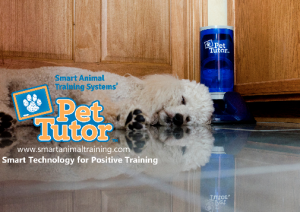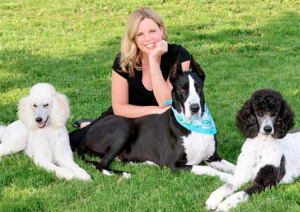 After unveiling Pet Tutor® for the very first time at the APDT conference in Spokane, WA, I can’t help but look back to the almost 30 years that I have worked with dogs and think of how dog training has evolved. There was no technology back then, no clicker, no treat-pouch, no laptop, not even prepackaged treats! We used choke chains and prong collars and cans filled with gravel, and the first real piece of technology 20-30 years ago, was shock collars. We have certainly come a very long way. Today, we have access to an ever-growing field of knowledge through scientific advances in animal cognition and behavior. Our growth in understanding of how we can communicate and teach our animals more effectively has led to the development of new tools and training techniques. The gathering of professional trainers and speakers, at the APDT conference, is a testament of how rich and diverse our industry has become. Keeping up to date on the latest canine information from the finest experts in the industry has now become a vital part of a dog trainer’s life (click here for a complete list of speakers). Following the scientific advances in animal behavior, technology has also focused on new and improved tools to enhance our pets’ lives through ways of communication, enrichment or positive reinforcement rather than means of punishment and coercion. The technology in Pet Tutor® was not even available a few years ago. What a great venue the APDT conference is to share with the animal professionals how modern technology is expanding our ability to apply science to helping dogs in everyday situations.
After unveiling Pet Tutor® for the very first time at the APDT conference in Spokane, WA, I can’t help but look back to the almost 30 years that I have worked with dogs and think of how dog training has evolved. There was no technology back then, no clicker, no treat-pouch, no laptop, not even prepackaged treats! We used choke chains and prong collars and cans filled with gravel, and the first real piece of technology 20-30 years ago, was shock collars. We have certainly come a very long way. Today, we have access to an ever-growing field of knowledge through scientific advances in animal cognition and behavior. Our growth in understanding of how we can communicate and teach our animals more effectively has led to the development of new tools and training techniques. The gathering of professional trainers and speakers, at the APDT conference, is a testament of how rich and diverse our industry has become. Keeping up to date on the latest canine information from the finest experts in the industry has now become a vital part of a dog trainer’s life (click here for a complete list of speakers). Following the scientific advances in animal behavior, technology has also focused on new and improved tools to enhance our pets’ lives through ways of communication, enrichment or positive reinforcement rather than means of punishment and coercion. The technology in Pet Tutor® was not even available a few years ago. What a great venue the APDT conference is to share with the animal professionals how modern technology is expanding our ability to apply science to helping dogs in everyday situations.

Wes Anderson – Founder of Smart Animal Training Systems
We all chose to become a dog trainer for different reasons, but what we all have in common, is our profound love for animals. We feel a connection, a deep bond with beings other than ourselves, a sense of compassion for those who cannot speak up for themselves. The more we learn about animals, the more we learn about ourselves, and the closer we feel to them. Studying and working with dogs and animals of all sorts during all of my adult life, I gradually expanded my ability to communicate with them and to assist others in developing a positive and rewarding relationship with their pet. Along with the success stories, also come the frustrations, the cases where we run into the limits of our ability to affect change and help with the situation. As dog trainers, we’re faced with the harsh reality of our profession. We witness the suffering of many dogs that we can’t help. From those who, left alone for hours on end, endure stress and anxiety day after day; to others who develop helpless strategies to overcome neglect, distress and boredom. Just the other day, I was in conversation with a fellow trainer who shared with me her frustration and sadness while working with an owner whose dog is chained in the back yard, desperate for attention and company. Convinced her dog is happier with her than he can ever be with someone else, the dog’s owner refuses to re-home the neglected animal.
We have the best behavior modification protocols we’ve ever had before and the most advanced and efficient training techniques, yet there are many times where applying what is needed is difficult, sometimes impossible. Our modern lifestyles force most dog guardians to work full time, leaving their pets to their own device for more hours than they can bear. In her last blog, Julie Hecht brought up one of a recent studies on separation anxiety in dogs in the UK. Amongst the 40 dogs who participated in the study, only 5 of them showed no signs of anxiety when left alone. Many of them showed clear evidence of distress by vocalizing, house soiling or chewing on the furniture. Separation anxiety is one of the most common behavior problems in our pet dogs. More surprising however, is that, out of the 19 dogs that were not showing any signs of anxiety and remained calm and quiet while left home alone, all of them showed increased levels of Cortisol. Unbeknown to their guardians, these dogs were also experiencing some level of anxiety. Staying alone is not easy for any dog and they need us to actively take the time to teach them that it’s OK but many guardians struggle to go through the process. In addition to prevailing behavior problems, it’s also difficult for many to apply some of the most basic of training programs. Owner compliance is still one of the great challenges our profession faces on a regular basis.

Amanda Hessel
Marketing Director
Many people today are techies and always on the lookout for new technological tools. I’m not one of them. My natural impulse is to just do things on my own, grab a clicker, a few treats and off we go. I have to recognize though that when it comes to helping dogs adjust to being left alone, technology can make a real difference and in some cases even provide the only solution. I was blessed to be part of the development of Pet Tutor® and contribute in my small way to providing new solutions to help dogs and their guardians. Along with Wes Anderson and his team of engineers, Amanda Hessel and my husband Jack Topham, we spent hours troubleshooting and testing new ways to address many of the most common yet difficult to address behavior problems (click here for more information about the team). We dreamt of new games for our dogs to play, where they could use up their energy, but also their cognitive abilities. We developed training protocols where repetitions could be automated and made easier to implement. We imagined, we over planned, we fantasized, we killed a few crazy ideas on the way, we simplified, and in the end, we created a device that we hope will offer solutions in areas that were up until now un-accessible.
The development of Pet Tutor™ has been an adventure; a challenging yet enriching and exciting adventure. All four of us will be present at the next APDT show and we’re anxious to let others discover this new technology with all of its features. We won’t be selling it just yet, so this will only be a sneak peak, but we’re looking forward to sharing Pet Tutor™ with our fellow trainers, behaviorists, veterinarians and researchers. In a venue where all are gathered for the benefit of our companion dogs, what better place than the APDT show!
Jennifer Cattet Ph.D.
Video : Pet Tutor(R) Overview features and Advanced Capabilities
Related articles





Oh Wow! I wish I could be there for the conference! It would be so cool to see a demonstration of the Pet Tutor!! I definitely need one that attaches to a crate! Please start selling them SOON!!
This is an exciting new product. As a shelter volunteer, I can’t help but think of the hopeful possibilities. Kibble dispenses when a dog walks by, kibble dispenses when the dogs are all quiet, etc. Maybe in the future, your business may consider marketing these for shelters.
I have concerns about using devices that dispense food as Pet Sitters.
It seems to me to be counter productive — the dog is not really learning to be calm when left alone.
And dogs do not need to graze all day.
I suppose my feelings are a result of having lost my heart dog to a poison bait because she was not taught to leave food lying around alone.
But then neither do I ever leave my dogs unsupervised in the house. They are left in a safe secure yard.
How lovely post.
Thanks for sharing us nice post……………………..